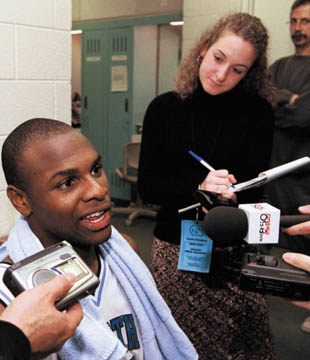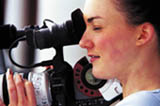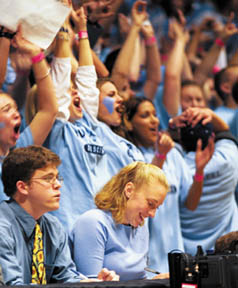
April 2001
 |
|
Senior Brooke Eidenmiller, an intern with the Athletic
Communications office, interviews Tar Heel center Brendan Haywood
after a victory over Florida State.
|
Leveling the field
More and more women are entering the traditionally male-dominated world of sports media
Photos by Maricarmen Josephs
In the age of powerful athletes like Mia Hamm and Marion Jones, being told that you throw, hit, kick, run or play "like a girl" is actually a compliment. Women today are discovering successful careers as professional athletes, with the creation of the Women’s National Basketball Association and the new Women’s United Soccer Association.
But the jobs don’t end on the playing field. More and more, women also are finding their way into careers in sports media. Although currently less than 10 percent of American print and broadcast sports journalists are women, those figures are changing — in the 1990s more than one-third of students enrolled in U.S. sports journalism classes were women. Female students and alumnae from UNC-CH are part of the cadre of women breaking through the statistics.
Why sports journalism?
Junior Rachel Carter became the sports editor at The Daily Tar Heel in January after two semesters as assistant editor. She sees sports journalism as a way to combine an interest in athletics with a love of writing.
 |
|
Junior Nicole Denman shoots a Carolina baseball
game.
|
"I love it — every week there’s something different," said Carter. "And there’s more room in sports journalism — it has to be part opinion."
Like Carter and many other female sports journalists, junior Megan Collins and seniors Lindsey Emery and Brooke Eidenmiller have combined interests in sports and writing into their intended careers. All three women work as interns in the University’s Athletic Communications office, formerly called Sports Information.
"I’ve always loved sports — the energy, the enthusiasm of its participants and fans," Emery said.
Collins, who also serves as manager for the women’s lacrosse team at the University, hopes to work with USA Swimming this summer. For her, covering sports is the next best thing to competing.
"If I can’t get to the Olympics as a participant, I might as well work for them," she said.
Eidenmiller agreed, saying that "although I’ve never been a stellar athlete, I have always been an avid sports fan."
"I love the competition and passion of athletics, especially in collegiate sports," Eidenmiller said. "Receiving this internship was a dream come true for me — I enjoy the fast-paced world of sports, and I like interacting with the media."
Robbi Pickeral (AB ’97), former DTH sports editor, now works for the St. Paul Pioneer Press as the beat writer for the National Basketball Association’s Minnesota Timberwolves. She follows the team at practices and games, traveling for half of the 82-game season.
"What I like about sports journalism is that it has a little bit of everything — news, features, human interest," Pickeral said. "Each day is different — recently I’ve not only covered the games and practices, I also wrote about a player who died, investigated a scandal about salary caps and wrote player profiles."
Sports journalism can be hard work, but Pickeral said it’s worth it.
"There are a lot of long days, but I’m very young to be doing this kind of work, and it’s a terrific opportunity," she said. "There are about a hundred people lined up who want my job."
Sports media at the School
The School does not currently offer a specific major in sports journalism, but there are classes for students interested in the field. Assistant Professor Charlie Tuggle teaches a sports announcing class that covers play-by-play, color commentary and sportscasting for TV news. Nine males and one female enrolled in Tuggle’s first class last summer, but he said his classes at the University of Alabama were closer to 30 percent female.
Also, Professor John Sweeney’s sports marketing class, which has been offered for six years, deals with journalism, advertising, marketing and media relations. The focus of the course is "an inch-deep look at the entire world of sports," including everything from golf tourism at Myrtle Beach to controversial hikes up Everest, from overweight kids who don’t exercise to the benefits and problems of Title IX, the 1972 federal statute that prohibited sexual discrimination in athletics.
"When I started, I was concerned about stereotyping, but the class has always been 50-50," Sweeney said. "The whole gender box doesn’t fit. Women and men perform equally in the class."
Emery said Sweeney’s class was helpful in her preparations for a career in sports media.
"The sports marketing class makes everything a lot more approachable. I know how it all comes together now," she said.
Sports journalists-in-training benefit not only from sports-specific courses, but also general courses within the School. Students say writing, design and public relations classes all help build the skills necessary in the world of sports media.
"It’s really hard to get into sports PR, but it helped that I got a great degree from a place like Carolina," said Katie Anderson (AB ’98), media coordinator for the Orlando Magic. "What I learned in JoMC classes, I actually use here everyday."
Pickeral echoed that sentiment, adding that the people in the School really made a difference.
"The J-school gave me a lot of opportunities, thanks to (Career Services Director) Jay Eubank, and the DTH gave me experience," said Pickeral. "But the professors really helped me, listening to people like Chuck Stone, Harry Amana and Jim Shumaker share their practical experiences."
Graduating with a journalism degree from UNC-CH is certainly a plus, but it’s not the only advantage for sports journalists at the University.
"Going to a school with one of the top athletic programs in the nation not only gets you excited by sports, it also gives you a lot of material to cover," said Nicole Denman, a junior. Denman works with "STV-Sports Extra" and volunteers with "Carolina Week," the School’s student-produced weekly news broadcast.
Carter agreed that "a good time for women in sports translates into a good time for women in sports journalism."
"With so many women’s teams at UNC that are doing so well – like national championship soccer and field hockey repeats — it really encourages the women who are in journalism," Carter said.
 |
|
Junior Megan Collins, seated, covers basketball
games and other athletic events as an intern with the UNC-CH Athletic
Communications office.
|
Women’s work?
Women in sports media isn’t a new concept — there are records of women sports writers in the United States dating back to the late 1800s. During World War II, Mary Garber was sports editor of an "all-girl staff" at the Winston-Salem Journal-Sentinel. Karen Rosen (AB ’83), sports writer for the Atlanta Journal-Constitution, named Garber as a role model because she "persevered despite being told that little boys were more welcome in the press box than working women."
"There’s a generation of women who broke the barriers into the locker rooms to pave the way for us," said Pickeral, who admired Christine Brennan when she wrote for the Washington Post. "Now the next generation has to further the field."
Title IX has served as a basis for breaking down more barriers, not just for female athletes but for women in sports media as well. In 1978, a U.S. District Court judge ruled that barring a reporter from a locker room would put her at a "severe competitive disadvantage" in doing her job. The ruling, which set the precedent for all gender bias cases in sports media, came after Sports Illustrated reporter Melissa Ludtke was excluded from major league baseball locker rooms.
But in 1991, Boston Herald sports reporter Lisa Olson filed a sexual harassment suit against the New England Patriots after several team members allegedly exposed themselves to her in the locker room, and one player invited physical contact. The Patriots agreed to settle and also paid fines levied by the National Football League.
So is being a female in sports media still a liability? Sweeney said the issue of gender is a moot point:
"The whole sense of women’s involvement in sports is a given. The revolution of women in sports is not a question of whether, but a question of when it will happen."
Today there are more than 500 women working in the once male-dominated worlds of sports media, as well as for professional teams, leagues and sports-related industries, though still relatively few of these women are beat reporters covering major league teams.
"It’s not really that uncommon these days, especially in the NBA," said Natalie Knorr (AB ’97), assistant director of public relations for the Charlotte Hornets. "There are female officials in the NBA, plenty of women who work in PR and some in upper management of NBA teams."
Rosen agreed, saying that "women are no longer a novelty in press boxes or locker rooms. These days, assignments are based on ability, not gender."
But even Rosen has faced discrimination in her career: She was barred entrance to the Vanderbilt locker room after a football loss at Georgia in the late ’80s.
"That wouldn’t have been a big problem except they refused to bring any players out to me," said Rosen. "I was hopping mad, because it was difficult to get the quotes I needed – I wound up following the players to the bus."
Rosen’s editor complained to the Southeastern Conference, leading the organization to establish the so-called "Rosen Rule," which means equal access for all reporters.
"I tell people it means that now we all stand outside, but actually different schools have different policies," Rosen said.
Collins and Carter said they have noticed that sometimes they are the only women among the media covering a story.
"At press conferences, especially football, there are really no women," Collins said. "But people usually assume that if you’re there, you know what you’re doing."
For Pickeral, being young was more of an obstacle than being a woman — she started covering the Timberwolves at age 23. Whether male or female, she said, you still have to earn respect.
"I’m sure being a woman does change things, but I decided early on that it wouldn’t be an issue for me," Pickeral said.
Denman said she hopes that being female can even be an asset in sports media.
"It is such a male-dominated field, and I think that people get excited about a female who knows about the sports she is dealing with and appreciates what is going on," she said.
Journalism first, sports second
Regardless of how much you may know about sports, professors, alumnae and students agree that being a great sports journalist means being a great journalist.
"Be good reporters, first and foremost," said Sweeney. "The top female sports journalists are damn good writers and reporters. You have to be grounded in the skill — it’s not about sports. Follow the discipline, not the athletics."
Tuggle’s research into trends in sportscasting makes the same point.
"Local sportscasting is moving away from reporting runs, hits and errors to telling sports stories that everyone finds interesting," Tuggle said. "The ex-jocks who don’t know journalism are being moved out — which is good news for all sports journalism students, both male and female."
Emery noted that women can be intimidated by assumptions that "you can’t compete with guys who were born with a stat book in their brain." But she stressed that women can learn the sports information they need.
"If you work hard and do well, you’ll earn even more respect than the men," Emery said. "Women are realizing that if you’re a good writer, you can write about any area of interest you want."
In fact, Pickeral said statistics really aren’t the story at all anymore.
"I can’t quote stats, but sports journalism has gone beyond that," she said. "A good journalist tells the story — sports are about people, not stats."
Pickeral also pointed to women like Lesley Visser, who became the first woman assigned to cover "Monday Night Football" for ABC in 1997, as evidence that you don’t need to have played a sport to be a good sports journalist.
Words of wisdom
Overwhelmingly, students and alumnae stress the significance of internships. With that in mind, the Association for Women in Sports Media (AWSM) sponsors internships and scholarships for college students. Established in 1987, AWSM comprises more than 600 women and men employed in sports media. Carter and Collins have been offered AWSM internships with the Newsday sports desk and the National Hockey League, respectively.
"Don’t underestimate the need for real experience," said Sweeney, adding that students should consider volunteer jobs with nonrevenue sports in addition to paid internships with publications.
Working in sports journalism is a valuable way to augment course material, Knorr said.
"No one can teach you the things you need to know in order to work with professional athletes," Knorr said. "You must learn by working with others in sports, by getting out there and seeing and doing it yourself. You can’t really learn the day-to-day ins and outs of sports PR in a classroom."
In addition to work experience, it’s also important to learn from other writers.
"Read everything and take note of what you like and what you don’t like," said Pickeral. "Read critically."
Rosen noted that the trends in online media are increasing the opportunities for women as sportswriters, but she cautioned that anyone considering a career in sports media must be serious.
"I once talked to a young girl who said she wanted to be a sports writer. It turned out that she just wanted to meet Chipper Jones," said Rosen. "So, if you’re really just a groupie, remember that it smells bad in locker rooms, there are so many people in front of you that you can barely hear the player anyway, and your story is due in 15 minutes."
Cyndi Soter is a first-year master’s student in the professional sequence.